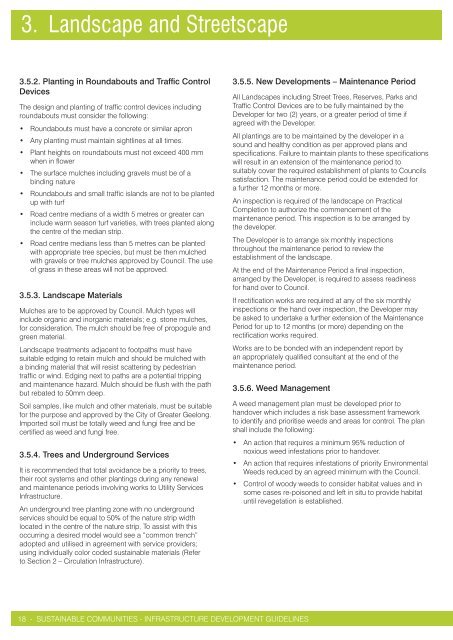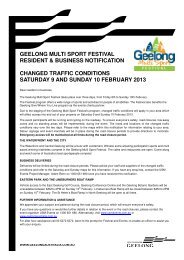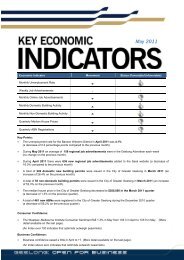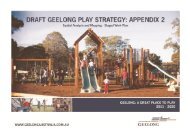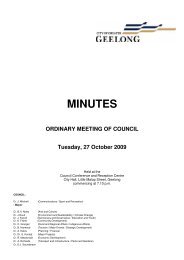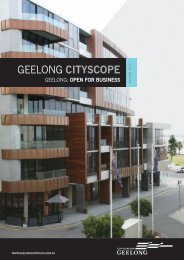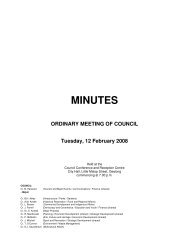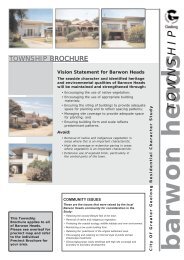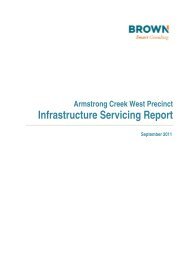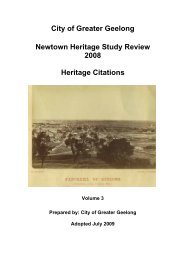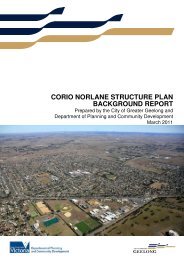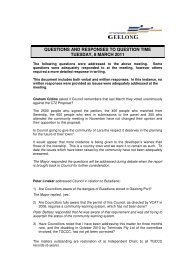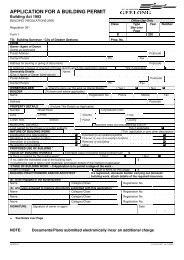3. Landscape and Streetscape - City of Greater Geelong
3. Landscape and Streetscape - City of Greater Geelong
3. Landscape and Streetscape - City of Greater Geelong
Create successful ePaper yourself
Turn your PDF publications into a flip-book with our unique Google optimized e-Paper software.
<strong>3.</strong> <strong>L<strong>and</strong>scape</strong> <strong>and</strong> <strong>Streetscape</strong><br />
<strong>3.</strong>5.2. Planting in Roundabouts <strong>and</strong> Traffic Control<br />
Devices<br />
The design <strong>and</strong> planting <strong>of</strong> traffic control devices including<br />
roundabouts must consider the following:<br />
• Roundabouts must have a concrete or similar apron<br />
• Any planting must maintain sightlines at all times.<br />
• Plant heights on roundabouts must not exceed 400 mm<br />
when in flower<br />
• The surface mulches including gravels must be <strong>of</strong> a<br />
binding nature<br />
• Roundabouts <strong>and</strong> small traffic isl<strong>and</strong>s are not to be planted<br />
up with turf<br />
• Road centre medians <strong>of</strong> a width 5 metres or greater can<br />
include warm season turf varieties, with trees planted along<br />
the centre <strong>of</strong> the median strip.<br />
• Road centre medians less than 5 metres can be planted<br />
with appropriate tree species, but must be then mulched<br />
with gravels or tree mulches approved by Council. The use<br />
<strong>of</strong> grass in these areas will not be approved.<br />
<strong>3.</strong>5.<strong>3.</strong> <strong>L<strong>and</strong>scape</strong> Materials<br />
Mulches are to be approved by Council. Mulch types will<br />
include organic <strong>and</strong> inorganic materials; e.g. stone mulches,<br />
for consideration. The mulch should be free <strong>of</strong> propogule <strong>and</strong><br />
green material.<br />
<strong>L<strong>and</strong>scape</strong> treatments adjacent to footpaths must have<br />
suitable edging to retain mulch <strong>and</strong> should be mulched with<br />
a binding material that will resist scattering by pedestrian<br />
traffic or wind. Edging next to paths are a potential tripping<br />
<strong>and</strong> maintenance hazard. Mulch should be flush with the path<br />
but rebated to 50mm deep.<br />
Soil samples, like mulch <strong>and</strong> other materials, must be suitable<br />
for the purpose <strong>and</strong> approved by the <strong>City</strong> <strong>of</strong> <strong>Greater</strong> <strong>Geelong</strong>.<br />
Imported soil must be totally weed <strong>and</strong> fungi free <strong>and</strong> be<br />
certified as weed <strong>and</strong> fungi free.<br />
<strong>3.</strong>5.4. Trees <strong>and</strong> Underground Services<br />
It is recommended that total avoidance be a priority to trees,<br />
their root systems <strong>and</strong> other plantings during any renewal<br />
<strong>and</strong> maintenance periods involving works to Utility Services<br />
Infrastructure.<br />
An underground tree planting zone with no underground<br />
services should be equal to 50% <strong>of</strong> the nature strip width<br />
located in the centre <strong>of</strong> the nature strip. To assist with this<br />
occurring a desired model would see a “common trench”<br />
adopted <strong>and</strong> utilised in agreement with service providers;<br />
using individually color coded sustainable materials (Refer<br />
to Section 2 – Circulation Infrastructure).<br />
<strong>3.</strong>5.5. New Developments – Maintenance Period<br />
All <strong>L<strong>and</strong>scape</strong>s including Street Trees, Reserves, Parks <strong>and</strong><br />
Traffic Control Devices are to be fully maintained by the<br />
Developer for two (2) years, or a greater period <strong>of</strong> time if<br />
agreed with the Developer.<br />
All plantings are to be maintained by the developer in a<br />
sound <strong>and</strong> healthy condition as per approved plans <strong>and</strong><br />
specifications. Failure to maintain plants to these specifications<br />
will result in an extension <strong>of</strong> the maintenance period to<br />
suitably cover the required establishment <strong>of</strong> plants to Councils<br />
satisfaction. The maintenance period could be extended for<br />
a further 12 months or more.<br />
An inspection is required <strong>of</strong> the l<strong>and</strong>scape on Practical<br />
Completion to authorize the commencement <strong>of</strong> the<br />
maintenance period. This inspection is to be arranged by<br />
the developer.<br />
The Developer is to arrange six monthly inspections<br />
throughout the maintenance period to review the<br />
establishment <strong>of</strong> the l<strong>and</strong>scape.<br />
At the end <strong>of</strong> the Maintenance Period a final inspection,<br />
arranged by the Developer, is required to assess readiness<br />
for h<strong>and</strong> over to Council.<br />
If rectification works are required at any <strong>of</strong> the six monthly<br />
inspections or the h<strong>and</strong> over inspection, the Developer may<br />
be asked to undertake a further extension <strong>of</strong> the Maintenance<br />
Period for up to 12 months (or more) depending on the<br />
rectification works required.<br />
Works are to be bonded with an independent report by<br />
an appropriately qualified consultant at the end <strong>of</strong> the<br />
maintenance period.<br />
<strong>3.</strong>5.6. Weed Management<br />
A weed management plan must be developed prior to<br />
h<strong>and</strong>over which includes a risk base assessment framework<br />
to identify <strong>and</strong> prioritise weeds <strong>and</strong> areas for control. The plan<br />
shall include the following:<br />
• An action that requires a minimum 95% reduction <strong>of</strong><br />
noxious weed infestations prior to h<strong>and</strong>over.<br />
• An action that requires infestations <strong>of</strong> priority Environmental<br />
Weeds reduced by an agreed minimum with the Council.<br />
• Control <strong>of</strong> woody weeds to consider habitat values <strong>and</strong> in<br />
some cases re-poisoned <strong>and</strong> left in situ to provide habitat<br />
until revegetation is established.<br />
18 - SUSTAINABLE COMMUNITIES - INFRASTRUCTURE DEVELOPMENT GUIDELINES


